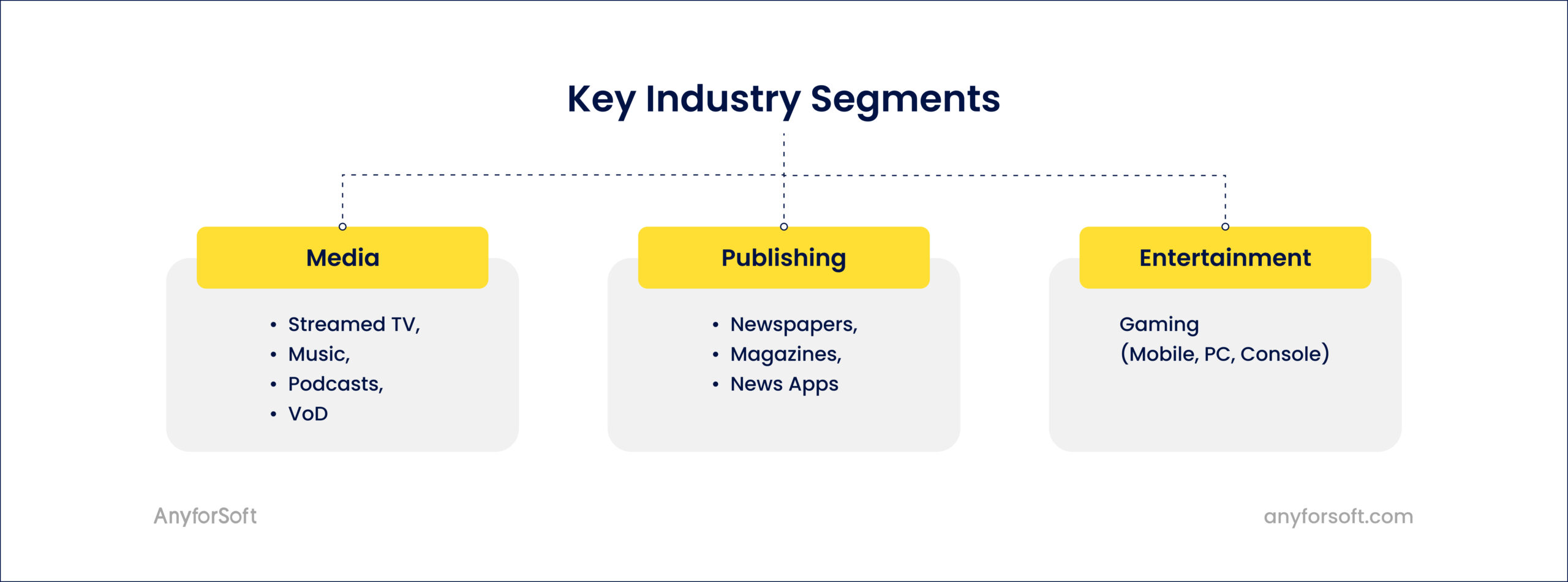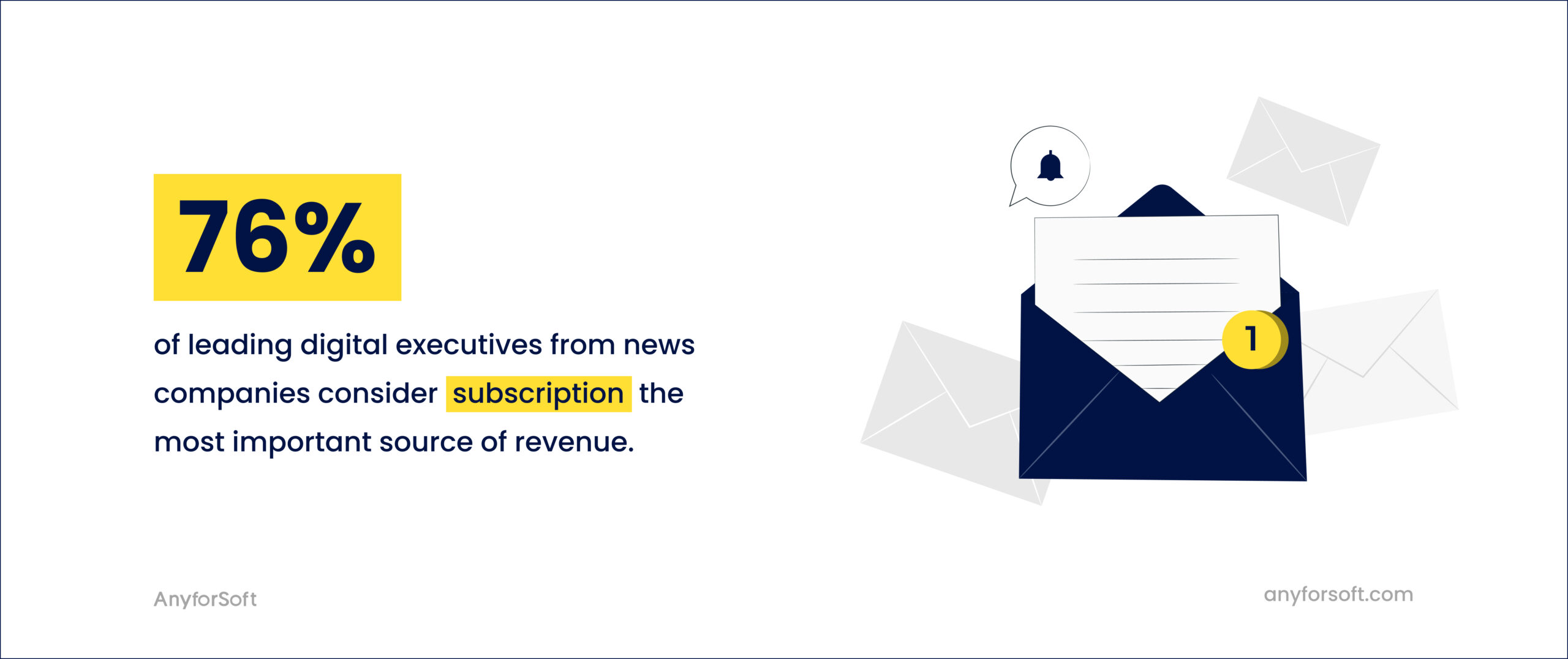Digital media is everywhere: you listen to it, you watch it, you interact with it. The digital media industry itself is constantly changing, growing and transforming following the main trends and needs of consumers: yesterday the whole world was crazy about radio and television, and today, when all this fits in your pocket, short entertainment videos are on the crest of the wave; and only true visionaries can know what will take the leading positions tomorrow. How do companies survive in such a rapidly changing environment? How do media companies make money?
Types of Digital Media Businesses
Before reviewing the digital media business models, let’s take a quick look at the types of digital media businesses. Conventionally, the entire industry can be divided into several large segments: Movies or Cinema, Television, Music and Radio, Publishing, Advertising and Gaming. However, companies often strive to reach the widest possible audience and are engaged in several types of media activities at once.

- Radios became things of the past a long time ago, but radio stations continue to broadcast digitally. Millions of users enjoy a huge selection of stations and databases of millions of songs using Apple and YouTube Music, Spotify, Tidal, etc.
- Visual is the king of content in the 21st century, and you can find anything from streaming movies and TV services like Netflix to virtual reality simulators. Of course, YouTube is the first to come to mind when something like this is mentioned: it has hosted billions of videos since its launch in 2005.
- Advertisers became a part of the digital media environment by taking advantage of marketing partnerships and ad space wherever possible. Today, instead of annoying pop-ups and flashy ads, advertisers are turning to native content and other ways to retain consumers.
- News, literature, and other types of publications are still on top. Traditionally, people read texts through books, print newspapers, magazines, etc. Although digital media has become widespread, the need for such a reading experience persists. Despite the widespread popularity of video and audio content, the need for written content is still high: news has migrated from paper newspapers to electronic ones, and the printed book is still actively fighting its audio counterpart.
- Games and Gamification have permeated every segment of digital media: you can see a game or quiz element in any kind of content and any digital media company. This is because the game, like nothing else, follows the main rule of digital media – to entertain.
So, how do all these content makers monetize products through services?
#1: Subscription
Subscription is one of the oldest digital media business models, introduced by print newspapers and magazines. For a long time, subscriptions remained outside the digital industry because the industry itself was not seen as promising. However, today, this particular model is one of the main ones for all companies in the entertainment segment.
The subscription is used by streaming and gaming platforms, music and news portals. The main rule here is to provide high-level content. Customers keep a close eye on what they are paying for and want a quality product.

#2: Freemium
Surely many already know how TV networks make money on the Internet. And the answer is Freemium. In fact, this is one of the forms of subscription, however, users are given access to basic content and only specials are available for a fee.
Constant advertising and marketing campaigns, influencers and broadcasting of benefits from a premium account, encourage users to pay for content and get more opportunities: not only early (or exclusive) access, but also a bonus program, perks.
#3: Paywall
Paywall subscriptions are often featured on the websites of newspapers and publications or video streaming services. The bottom line is, access to content is allowed only after registration and payment.
There are two types:
- Softwall allows users to study from 3 to 5 materials for free in a limited time (day/week/month). If this limit is exceeded, the user is asked to pay for the subscription.
- Hardwall completely blocks content for unregistered users without a subscription.
Such a media company business model is more difficult to implement and, despite the rigor, requires flexibility in the methods and terms of payment.
#4: Membership
Something you’d expect from a country or sports club is now offered in online communities. The main difference between membership and other types of subscriptions is that users get several levels of membership to choose from and truly become part of the community, i.e. decision-makers.
Membership involves not only bonuses and a flexible loyalty system, but also taking part in surveys and influencing content. By the decision of the majority, some material can be published more often, and some, on the contrary, disappear from the platform.
Managing a digital company with such a monetization system can be a challenge, but the benefits are commensurately great: growing loyalty leads to growth of profits as well.
#5: Licensing
Of all the digital media revenue models, licensing is one of the most popular on television and video platforms, actually, this is how production companies make money.
How does it work? In simple terms, the production company or house takes on the work of only producing content and licensing it, and then sells it for promotion, advertising and distribution through selected channels, usually cinemas, TV channels and streaming video platforms.
The downside of the model is that the content owner no longer controls how the audience interacts and perceives the end result.
#6: Sponsored/Featured posts
Do not confuse it with sponsorship or donation! Sponsored or featured posts are usually of an advertising nature, but are directly related to the activities of a media company or person. Usually, they are marked with a special plate or hashtag, warning about the presence of native integration in the content.
This digital media revenue model is widely used by both small and large companies, allowing them to naturally build brand loyalty and gradually increase interest in it.
Even though advertising companies are part of the media industry itself, advertising as a digital media business model is also often used. Many people call this method one of the most familiar and effective, others rather follow their customers and strive to offer a service promptly. As mentioned above, the native way of promoting a product is now more appreciated, and therefore native advertising is still at its peak. At the same time, pop-ups and ad blocks on news sites are still collecting their clicks.
Events as a digital media business model seem to be something not obvious, but quite understandable. In fact, this cannot be called an independent way of earning money, but rather a platform for some others: sponsorships, tickets, booths (display), and product sales (publications, subscriptions, branded merchandise). Moreover, this is a great experience to unite like-minded people, rally the ranks of admirers, and acquire new ones.
So, you have a digital media company, or you are just starting one and need advice from professionals and industry gurus? Feel free to contact our managers to find the best solutions for you and choose a monetization model, develop and implement the necessary functionality.








